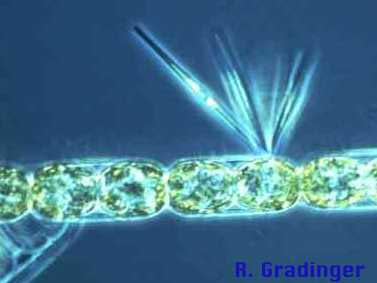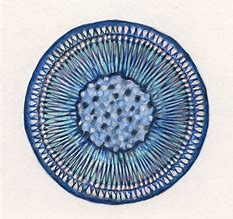Remaining in the world of the microscopic, in this article we look at small plant-like creatures called diatoms. Diatoms are single celled algae that float in the surface waters of the Gulf of Mexico in the billions. Being plant-like, they possess chlorophyll for photosynthesis. In fact, they possess two forms of chlorophyll, and another photosynthetic pigment called fucoxanthin. Chlorophyll gives plants their characteristic green color, fucoxanthins are more yellow in color and give the diatoms the common name green-yellow algae.
To collect them scientists pull what is called a plankton net. This net is funnel shaped with the diameter of the large opening being from several inches to several feet. The mesh is of a cloth material with extremely small holes to allow water to pass but not the plankton. The plankton net is deployed off the stern of the ship/boat and towed slowly at a specific depth. Once back on board the sample can be observed in a microscope.
Diatoms are one of the more abundant microscopic plant-like algae called phytoplankton. They differ from other phytoplankters in that they do have the yellow-green color to them, but they also possess a clear glass-like shell called a frustule. This frustule is made of silica and comes in two parts. The top half is called the epitheca and the bottom half the hypotheca. The two halves fit together like the two plates of a petri dish. This frustule often has spines extending from it giving the diatom the appearance of a snowflake – and under the microscope they are beautiful. These spines actually serve a purpose. It is important they remain near the sunlit surface. To reduce sinking, these spines increase their surface area creating drag and reducing the chance they will sink. Most also produce gas pockets within the cytoplasm to make them more buoyant.
All diatoms are subdivided into two groups based on their frustule shape. Some have circular frustules and are called centric diatoms. Others are more elongated and are called pennate diatoms. Scientists currently estimate there are between 100,000 and 200,000 species of them. Though they are abundant in all the world’s oceans, they seem to be more abundant in cooler waters.
To say they play an important role in ocean ecology is an understatement. Between them and their other phytoplanktonic cousins – phytoplankton produce about 50% of the world’s oxygen. In an open ocean environment like the Gulf of Mexico where the seafloor is beyond the reach of the sun, diatoms, and other phytoplankton, are referred to as the “grasses of the sea”. They are the base of almost all marine creature’s food chain.
When diatoms die (which is often in less than a week) their silica shells will eventually sink to the seafloor forming a layer of silica called “diatomaceous earth”. This sediment layer is commercially important as an abrasive. You will see diatomaceous earth labeled on toothpaste, household cleaners, soaps, anything with a little grit in it to help clean. It is also used in air and water filters to help purify such. You find these filters in aquariums, swimming pools, and hospitals.
If you collect a glass of water from the Gulf you are not going to see them without a microscope but know that the glass is full of these beautiful, amazing, and important marine creatures of the northern Gulf of Mexico.
- Tips for Bear Encounters this Fall - November 10, 2025
- Pensacola Bay Invasive Species Summer Survey 2025 - November 3, 2025
- Our Environment: Part 24 – Our Changing Climate - November 3, 2025




